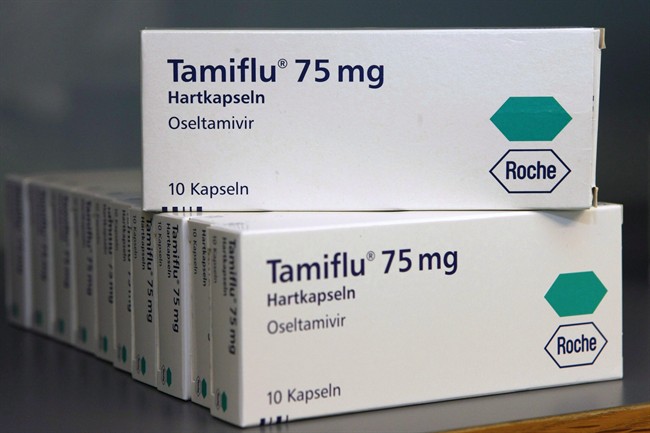TORONTO – A large international study suggests that sometimes maligned flu drugs saved lives during the 2009 H1N1 pandemic.

The work, which is based on data from 38 countries, suggests that deaths were 25 per cent lower among hospitalized adults who were given the drugs than patients who did not receive the treatment.
And deaths were 50 per cent lower during the pandemic among hospitalized adults with H1N1 who were started on the antiviral drugs early when compared to patients who did not get the drugs at all.
Oddly, the study did not show that the drugs had the same mortality reducing effect in children.
The senior author of the study says the findings support the decisions by many governments to stockpile the drugs as part of their pandemic response plans.
READ MORE: Flu shot halves risk of heart attack or stroke in heart disease patients, Canadian study suggests
Jonathan Nyugen-Van-Tam says the work suggests flu antiviral drugs should be given to adults admitted to hospital with suspected or confirmed flu infections.
The study was published in the journal Lancet Respiratory Medicine.
The drugs under study are called neuraminidase inhibitors, a class of drugs mainly made up of oseltamivir (Tamiflu) and zanamivir (Relenza).
- What is a halal mortgage? How interest-free home financing works in Canada
- Capital gains changes are ‘really fair,’ Freeland says, as doctors cry foul
- Budget 2024 failed to spark ‘political reboot’ for Liberals, polling suggests
- Peel police chief met Sri Lankan officer a court says ‘participated’ in torture
Many governments, including Canada’s, put together large stockpiles of the drugs in the years preceding the 2009 pandemic, when concerns were high that a pandemic might be looming.
READ MORE: What caused a whooping cough epidemic? Scientists blame parents
In the wake of the H1N1 pandemic, which was milder than many had anticipated a pandemic would be, critics questioned the decision to spend scores of millions on the antivirals.
The criticism was fuelled by studies that show that when used to treat uncomplicated cases of seasonal flu, the effect of the drugs is modest.
Nyugen-Van-Tam says he and his colleagues wanted to see if the pandemic stockpiles had delivered the benefits governments hope they would.
“We went into the 2009 pandemic with – I think – pretty scratchy data on whether neuraminidase inhibitors reduced mortality or not,” says Nyugen-Van-Tam, a professor of health protection at the University of Nottingham in Britain.
READ MORE: Should flu shots be mandatory for health care workers?
“We needed an answer as to whether antiviral drugs are a useful or sensible part of the pandemic armamentarium. And my view is … that they are a worthwhile intervention.”
The research was funded by Hoffman-La Roche, the Swiss drug giant that makes Tamiflu.
The study makes clear the company had no hand in designing or carrying out the study and had no access to the data, either before or after publication. In fact, for transparency purposes the researchers posted the contract with Hoffman-La Roche on the project’s website, hosted by Nottingham University.
For this work, the researchers searched for studies done comparing outcomes of hospitalized pandemic H1N1 patients who received antiviral drugs to those who didn’t.
They then asked the researchers who had done those studies to share their raw data – case by case information – which allowed them to analyse all the data in the same way.
They amassed a pool of 29,234 patients from 38 countries.
The analysis suggested that taking the drugs early – they are considered most effective in the first two days of illness – may have halved adult patients’ risk of dying. They also saw what looks like substantially higher odds of survival in pregnant women who were given the drugs, and in patients who required critical care.
There was no reduction in deaths seen in children who were given the drugs. The researchers suggested that might be due to a number of factors, including the possibility that infected children may have had more virus in their systems – a higher viral load – or more secondary bacterial infections.
READ MORE: What you need to know about avian flu (H5N1)
Another study, published last fall in the journal Pediatrics, showed a two-thirds reduction in deaths among critically ill children treated with these antiviral drugs.
The study cannot be used to definitively say that neuraminidase inhibitors were responsible for the lower death rates in the adults who received them. Only studies where patients are randomly assigned to get or not get a treatment can be said to prove causality.
But Dr. Kumanan Wilson, a senior scientist at the Ottawa Health Research Institute and a former skeptic about the value of flu antivirals says the results were “reasonably compelling” that the drugs do work.
“Vaccines would be great but they’re never available in time with pandemic (flu) strains,” Wilson says. “So all we’ve got is the antivirals. So it’s nice to see that there’s a benefit to them.”
READ MORE: Why the WHO is calling H7N9 one of the ‘most lethal’ flu viruses
A commentary published with the study says the findings underscore the need to quickly identify influenza cases among hospitalized patients and start drug therapy as soon as possible.
“As expected, early treatment seems to be optimal, and treatment shouldn’t be delayed by even one day to wait for diagnostic test results,” writes Dr. Alicia Fry of the U.S. Centers for Disease Control’s influenza division.
“However, if the patient presents for care more than two days after illness onset, treatment might still have some benefit, especially if they are severely ill.”



Comments